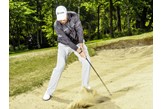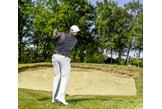Tour Pro Masterclass: Short Game
Published: Last updated:
Lowry and Kjeldsen Masterclass: Your two-for-one guide to chipping, wedge play and bunker shots
Soren Kjeldsen doesn’t fit the mould of your typical European Tour player. Quiet and unassuming, he’s also one of the shortest pros on tour – both in size and vigour. Standing at 5ft 7 inches the 40-something Dane averages under 275 yards off the tee and is often forced to lay-up on par 5s and attack par 4s with long irons. This, he acknowledges, places extra pressure on his short game, which is why he spends two hours every day fine tuning it. And the stats suggest it’s paying off.
Ranked inside the top 60 for scrambling every year on the European Tour since 2013, Kjeldsen has made a career out of plotting his way around the course with the precision of a milled Cleveland wedge. He also has four wins to show for it – the same number Shane Lowry has totted up across golf’s two top tours. Like Kjeldsen, the Irishman devotes a large chunk of his practice time to his short game, which has made him the envy of his peers on tour.
Up until the age of 12, Lowry learned the basics by playing pitch and putt with his mates every summer. He then graduated to Esker Hills, “a little- known golf course in Ireland”, featuring a bunch of elevated greens. Lowry recalls how, without coaching, he taught himself how to chip with spin. That artistry formed the bedrock of his rise into the professional ranks, not to mention his victory at the WGC Bridgestone Invitational three years ago.
He ended the 2015 PGA Tour season ranked 10th for scrambling inside 10 yards, with a 91.97% success rate for getting up and down. He admits his wedge play has slipped since then, a factor he puts down to struggling to acclimatise to the firmer greens in the US.
He remains, however, “one of the best chippers in the game,” according to Graeme McDowell.
With this in mind, we asked Lowry and Kjeldsen to breakdown the basics and share some of their secrets to short game success. So, sit back, grab a pad and start making notes. You might just start pitching like a pro!
THE SET UP
SK: It sounds easy, but the key to a good short game is a solid strike. That’s the No.1 thing. Gapping and everything else comes after that. Most amateurs who I play with in Pro-Ams are guilty of shifting their weight too much when pitching. I used to do the same, which is why I keep my feet quite close together, almost so they are touching. I started doing this with chipping, and it’s basically spilled over into my pitching. Doing so limits any kind of left-to-right movement, and keeps my weight very centred. A good starting point is to hit shots on the range with both feet together. If you do move off the ball, you will fall over. For stability and a solid strike, it’s a really good drill to build consistency and stop you from hitting it thick and thin.
SL: When I was playing at the Players Championship this year, I was really struggling with my bunker play and my coach noticed that I wasn’t very stable, and swaying in the backswing. That’s a common mistake I think most amateurs make, as well as standing too narrow. When you’re in a bunker, you need a wide stance so you can get low and feel like your feet are welded to the ground. If you can hold that position in your backswing, you’ll be able to deliver the club with better consistency.

SK: With wedge play, I always try to catch the ball first and then the turf after. Having a consistent set-up routine is a big part of that, which is why I don’t believe in standing open to the target. You can’t judge distance if you cut across it. I want the ball going straight up the face, not sliding off the face. It’s the same with chipping. For example, when I hit my wedge shots I generally hit them with a slight draw because I want to put a lot of face on the ball. I also move my weight forward (60/40) and the ball slightly back in my stance to achieve a ball- first contact. This is a lot easier to achieve consistently when your feet are close together.
WHY A WEDGE FITTING IS SO IMPORTANT
SOREN SAYS… It’s something most people probably don’t give a lot of thought to, but if the lie angle or bounce of your wedge is ill-suited to your swing and set-up, I guarantee you will struggle to achieve a consistent strike, regardless of how good your technique is. Custom fitting is a hugely important aspect, and so is having a clean ball and clean grooves. If I hit three shots and I don’t clean the grooves, on the fourth shot I can see the difference in spin. It’s enormous, and I’m hitting off nice fairways.
Most club golfers are hitting off fairways with more grass or with mud on them. If you want control and to spin the ball, clean grooves is No.1. No.2 is the ball. If you’re playing with a rock, it’s not going to spin. That’s why I love using the Srixon Z-Star XV ball. It reacts exactly how I want it to. Without question, it’s the best ball in the wind. The newest model is probably even better. It’s slightly softer around the greens, and especially when I’m chipping out of the rough, I get a little bit more grip than I used to.
THE SWING
SL: If you’re during it or thinning it, the chances are you are trying to scoop the ball up into the air. You’re better off hitting down on the ball. Believe it or not, that’s how you achieve a cleaner strike. It’s not about trying to nip the ball off the turf.
SK: I think most people – whether they’re hitting a pitch shot or bunker shot – instinctively feel like they need to stay on the right side to y it high. But that’s not the case at all. If you’ve got a 60-degree wedge in your hand, you don’t need to help the ball in the air. The loft will do that for you.
SL: Too many people decelerate into impact, and that’s where the fats come from. You have to be aggressive when hitting chips and pitches, and commit to the shot you are trying to hit. You can’t be scared. Like Soren said, it’s about trusting your loft.
SK: When I play with amateurs, I often turn my back towards them and just listen out for the contact. Listening to every shot is the best kind of feedback because it tells you how you’ve delivered the club.

STRATEGY
SL: Picking the right club and the right shot is probably where most people come unstuck. If you’re a 28-handicapper, it’s not worth the risk of playing a flop shot over a hazard, just so you can attack the hole. Get the ball on the ground, running on the green, as quickly as possible would be my advice. If that means playing away from the hole slightly, so be it. Trying to get every chip shot inside 15 or 20 feet should be your target, because we can all hole a 20-footer. Most people focus too much on the hole when they should actually be thinking about course management and giving themselves the best chance of success.
SK: If you’re a low handicapper, that’s when you can start being more aggressive with your pitching. If the pin is at the front, I like to hit a full shot and let the spin bring the ball back. Whereas if the pin is at the back, I like to hit a three-quarter shot with a lower-lofted club. I also hood the face slightly so the toe points in and the face is angled left. This helps to limit the spin so it hops forwards and checks without coming back.
It probably sounds complicated, but the actual technique of the shot never changes. The only thing that I do change is the length of my swing. But the furthest I ever swing back is 60, maybe 65 per cent. A pitch shot is all about control. I try to create nice gaps between my wedges so I don’t end up in a situation where I need to take too much of a shot. That’s really what I use Trackman for in my practice, so I can perfect my distances.

PRACTICE, PRACTICE, PRACTICE
SL: It’s a bit of a cliché, but practising with purpose is important as well. I like to play a few games to replicate the pressure of competition. When I’m at a tournament with Padraig [Harrington], we head to the short game area and play three or four games for 50 dollars or euros, depending on where we are. Normally, we’ll say first to 10, nearest to the pin. If you chip in, you get two. It’s a simple game, and if you win your point, you pick the next shot to suit you. Personally, I think mini competitions like that are the only way to practise. I don’t see the bene t of hitting the same pitch shot 50 times. If you’re with your friends, just play nearest the pin and whoever loses buys the drinks.
SK: I spend hours practising my short game every day. A normal day at home, I hit balls for two hours on the range, spend two hours on my short game and then go out and play 18 holes. Scrambling is a massive part of the game. Nobody hits more than 13 greens a round, so even the best ball strikers have to get up and down ve times.
SK: The key is to keep things simple. When I’m setting up to hit a pitch, one thing I focus on is making sure my feet are quite close together and that I remain balanced throughout the swing. I’m not looking for much more than that. From the moment most amateurs set-up to the shot and take the club back, I could go and have a cup of tea. There’s a massive delay! The longer that pause is, the longer the list is they have to remember. I’ve played on tour for 20 years and I’ve never played one round with more than one trigger. I think it’s unrealistic to have eight when I can only cope with one!
THE ONE PIECE OF ADVICE I WOULD GIVE
SL: To not overthink things. I’ve seen it happen so many times. They miss a green and before they even play the next shot, they’re already thinking about making bogey or worse. The moment you do that, you’re creating tension in your arms and body. To get rid of that fear factor, a good piece of advice would be to feel like you’re gripping the club as you would hold a butterfly. If you can see white knuckles, you’ll know you’re gripping too hard. Commentators talk about soft hands, and that’s what soft hands is.
SK: To not worry about gapping until you’ve mastered the strike. Most amateurs hit the ball too far behind, therefore weight distribution and staying centred is very important. As a player, my view is very practical. I’m not interested whether the club is behind or in front, or if the face is open or shut. Can you deliver the club properly? If you can do that, the style doesn’t matter. Everything I do is impact related. I could give a lot of technical tips, but again everything comes back to your impact. I recommend people use impact tape or study their divots, which will show if you created the divot after the ball and delivered the clubface square at impact.




